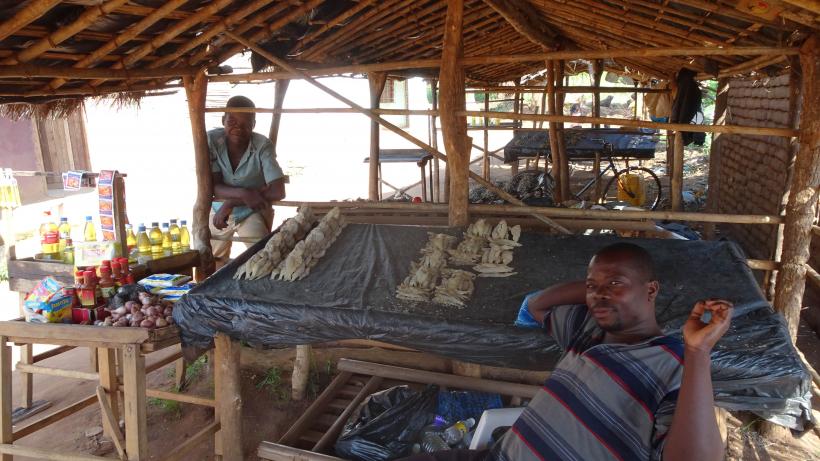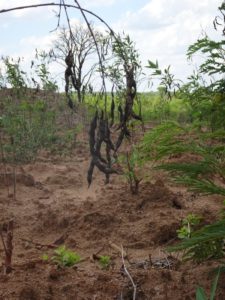
A socio-economic crisis in rural Mozambique
The districts of Middle and Upper Zambézia, in Central Mozambique, were most affected by the fall of the pigeon pea price in 2017. Most farmers did not have any financial return to their investment in the previous agricultural season, which created multiplier effects in the local economy.
Mozambique has been going through difficult economic times since 2015. This has been brought on by the uncovering of hidden debts and subsequent cuts in foreign aid, and by lower international prices of the country´s main export products, such as coal and aluminium. This situation resulted in a steep depreciation of the local currency, the Metical (MZN), and an increase in the rate of inflation and the fiscal deficit. The crisis seems to have reached its peak in 2016, with a gradual economic recovery taking place in 2017. Paradoxically, for millions of Mozambicans in the Centre-North of the country, particularly in Zambézia province, 2015 and 2016 were years of economic prosperity. Although they felt the macroeconomic crisis through the higher price of imported consumer goods, they simultaneously experienced a boom in the rural economy, thanks to high prices of agricultural crops, principally pigeon pea and maize. A farmer with four hectares of pigeon pea could make up to MZN 100,000. Throughout the province, farmers expanded their pigeon pea areas, and used the profits to buy motorbikes, mobile phones, televisions and solar panels, to improve their houses, and to invest in their children´s education. Thus, the high income to the farmers also generated lots of business opportunities in other economic activities.
However, the situation changed drastically in 2017, due to the decline in the farm-gate price of the two most important crops in the districts of Middle and Upper Zambézia, namely the maize price, which fell from MZN 20/kg in 2016 to MZN 5/kg in 2017, and the pigeon pea price, falling from MZN 45/kg in 2016 to MZN 5/kg in 2017.
Impact on the agricultural sector
Januário Malata is a farmer in Milange District, 10 km from the district capital. Encouraged by the high pigeon pea price of recent years, he allocated most of his cultivated area, 3 hectares in 2016-17, to this crop, together with maize, resulting in a pigeon pea harvest of 700 kg. On the small area remaining, he produced maize, cassava, and vegetables. Januário depends on informally contracted labour (known locally as ganho-ganho) for cultivating the 3 hectares, investing more than MZN 20,000. With the 2016 pigeon pea price of approximately MZN 45/kg, he would have earned MZN 31,500 just from the pigeon pea. However, given the price collapse, he was forced to sell at MZN 4/kg. Under normal circumstances, he would keep 50 kg of pigeon pea for his own consumption, but with the extremely low price, he preferred to keep 300 kg. As such, he only earned MZN 1,600 from selling pigeon pea. He had some income from maize and his vegetables, but insufficient to compensate the loss on the pigeon pea, leaving him without financial means to invest in contracting manual labour for the next agricultural season. He will try to cultivate 3 hectares again, using his own family's labour, but he is not sure whether he will manage.
Januário´s brother-in-law, meanwhile, had a large pigeon pea area of ten hectares in an isolated area. Unaware of the market conditions, he harvested the peas, arranged for transport, and took his produce to the closest town. While he was preparing the transport to the final destination, he received information on the market price he would be getting there, and reached the conclusion that it would hardly compensate his transport cost. Therefore, he decided to cancel the journey and abandoned his pigeon pea, fruit of his time and efforts for almost a year, in the bush.
In the neighbouring district of Morrumbala, Mr Ardicha invested almost MZN 250,000 and cultivated a total area of 26 hectares, with 10 hectares of sesame and 16 hectares of pigeon pea (intercropped with maize), having invested almost MZN 250,000. The sesame harvest failed completely due to pests and insects, a problem faced by many sesame farmers in Zambézia. Sesame is a relatively vulnerable crop, and requires the application of pesticide at specific intervals, but most farmers do not have access to such inputs. The major advantage of pigeon pea is that it has little production-related risks, resulting in stable yields. However, 2017 showed that pigeon pea does have another major risk, related to its commercialisation. Given the price collapse, Mr Ardicha reckoned that it would not even compensate him for the labour cost of harvesting 16 hectares and transport costs, and decided to leave the pigeon pea in the field where it already started rotting away with the onset of the first rains and increase in humidity levels. He incurred a loss of MZN 200,000 and will not have the financial resources needed to invest in the next agricultural season, so he will have to drastically reduce his cultivated area, including that of other crops like maize.

Pigeon pea rotting in a field
Thus, it is likely that the overall cultivated area in Zambézia will go down next season. The smallholder farmers who normally have up to two hectares and do not contract ganho-ganho labour will be able to maintain the same cultivated area. But the medium and emerging farmers, who have four hectares or more, depend on contracted labour. Not having this option due to a lack of resources, they will be forced to reduce their area. This implies that the total volume of contracted ganho-ganho labour will also reduce, or that its remuneration will fall. It is still early to determine the impact on the ganho-ganho market because the preparation of the fields for next season is still in its initial stage, but in Milange and Mocuba, a drastic reduction of the price paid for ganho-ganho has already been observed. In some cases, the labourers do not accept the lower wage, and no transaction ends up taking place.
Impact on the local economy
The economy of Central-Northern Mozambique is still, to a large extent, supported by the agricultural sector. When the farmer has no financial returns, he cannot buy other products, which immediately impacts the business of traders and retailers. If one enters any shop or business that depends on the local market in the district capitals of Middle and Upper Zambézia, one will find the owner lamenting that business is down at least 50% when compared to 2016. This trend is observable in practically all types of shops, from supermarkets, to general stores, from to shops selling clothes, to those selling building materials, and also in the services sector, like among tailors and bars. Businessmen confirm that some have already closed shop, and they expect more to follow that path in the coming months. Those who have been in business for a long time confirm that there have always been cyclical crises linked to agricultural prices, but that 2017 is one of the worst in memory. Small shops located in the countryside, away from the district capitals, face a fall in business volume of up to 80%.
Small shops located in the countryside, away from the district capitals, face a fall in business volume of up to 80%.
This picture repeats itself throughout Middle and Upper Zambézia, where maize and pigeon pea dominated the last agricultural season. In these areas, it is estimated that at least 75% of farmers grew pigeon pea, and that 50% did not have any other cash crop. Some cultivated sesame, but the harvest failed in many cases. It is important to note, however, that the situation is not necessarily the same throughout Central and Northern Mozambique. In various districts of Nampula province, for instance, many farmers did grow pigeon pea, but simultaneously had other cash crops, like cotton, soybeans, common beans, cashew, and others. Additionally, there is a commercial market for cassava. Thus, few farmers in this region depended on pigeon pea for a significant part of their income. The low pigeon pea price upset the farmers, but it did not create a local economic crisis.
Nampula City is the main commercial centre for the northern part of the country, as well as for many districts of Zambézia. Traders and shop-owners from these districts travel to Nampula to buy their merchandise. Businessmen interviewed in Nampula report that their business volume fell by 30 to 50% compared to 2016. In recent weeks, there was a slight recovery with the start of the cashew commercialisation, which led to a financial injection in major cashew-producing districts, such as the coastal districts of Nampula province.
Measures to revitalise the economy of the affected districts
The economy of the districts most affected by the low prices of pigeon pea and maize are in need of a financial injection because without it, the multiplier effects could continue to accumulate, leading to more business closures, and a consequent decline in tax revenues.
With the government facing tight fiscal conditions, it will not have the resources to provide the required economic stimulus with public funds. Therefore, we recommend that donors should consider organising cash transfers to farmers of the most affected districts.
In parallel, a joint effort should be launched by the Government, development partners, and private sector, to support diversification in the 2017-18 agricultural season. Many of the farmers in these districts are planning to continue focusing on pigeon pea production because they believe the price could recover next year, but also because they have no easy access to seeds of alternative cash crops. However, the next pigeon pea harvest will only take place from August 2018 onwards, and it is not likely that the price will be significantly higher. The estimates of Indian pigeon pea production currently in the field suggest that another abundant harvest is on the way, significantly above average annual consumption, while the warehouses are still full of pigeon pea from the previous season.
The diversification effort in the district of Middle and Upper Zambézia could focus on mung beans, common beans, and sesame. For the latter one, however, its promotion is not advisable in the absence of extension support and access to pesticides. Common bean is mostly destined for local consumption, both in rural areas and urban settings, including the capital Maputo. In recent years, the price of common bean has been relatively high and stable. Finally, mung bean would appear the best option, as it has an export market, but is also popular for domestic consumption. While mung bean production is common in Nampula province, it has largely disappeared in Zambézia. Many farmers say they remember their parents growing mung bean, and that they would like to take it up again, but that it is not easy to get seeds in these districts. Others say that, if they were the only ones in their district growing mung beans, they would have difficulty in finding buyers, as these would lack economies of scale in mung bean trading.
Considering this, a joint effort between government, development partners, and the private sector for re-introducing this crop in the districts most exposed to the pigeon pea crisis would be pertinent. The provision of seeds, together with purchasing commitments from traders, could entice many farmers to grow mung beans, even if on small areas. Mung beans can be planted until January or February, and harvested in April. It would seem realistic to expect a farm-gate price of MZN 15-20/kg, which means that a concerted effort in December could translate itself into a much-required financial injection for these districts by April.
Editor’s Note: The Portuguese version of this blog can be found here

